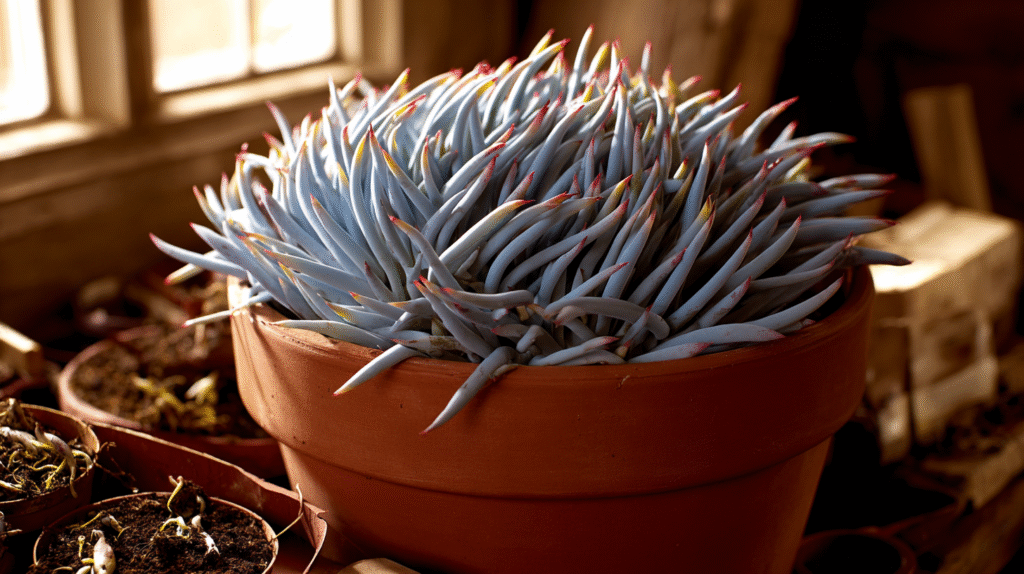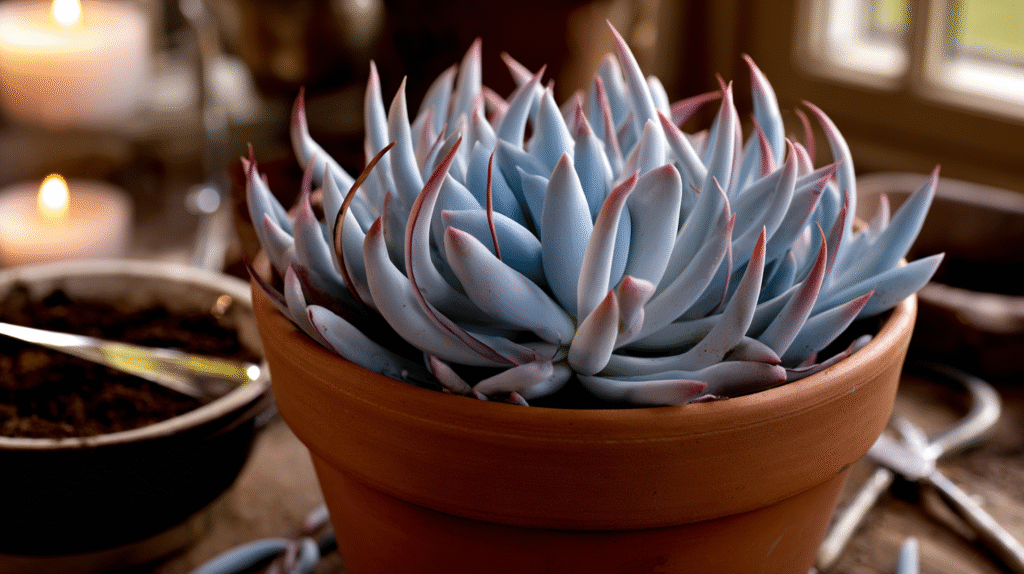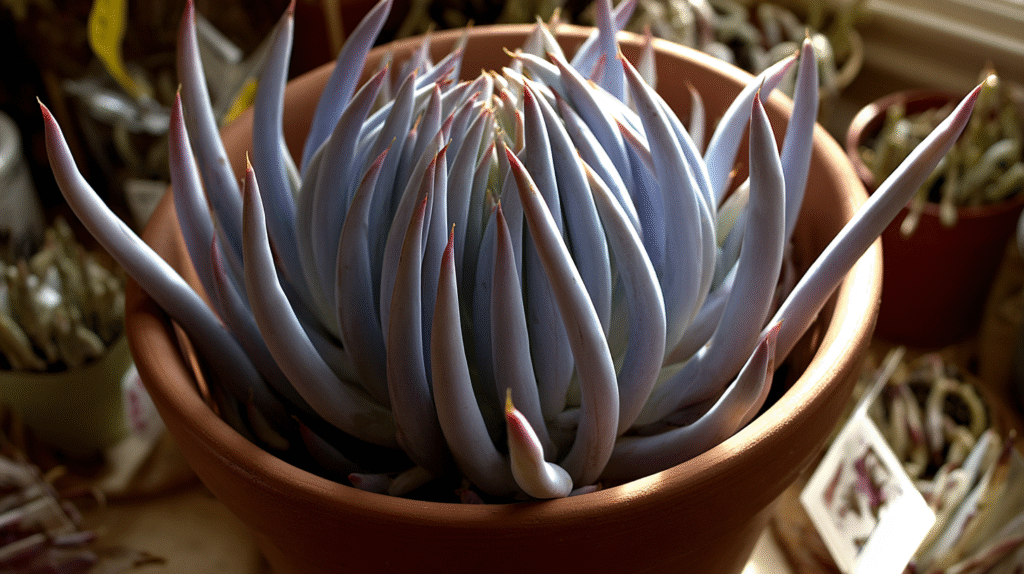I bought my first blue chalksticks on a whim, seduced by those powdery blue fingers reaching out of a 2-inch pot at Home Depot. “Another succulent to murder,” I thought, adding it to my cart alongside the clearance echeveria I was definitely going to overwater within a month.
That was three years ago. The echeveria died (shocker), along with a string of pearls and something labeled “assorted succulent” that never stood a chance. But that little $3.99 chalksticks? It’s now a sprawling blue masterpiece that stops visitors mid-sentence with its alien beauty.
Turns out, Senecio serpens (blue chalksticks) might be the most forgiving succulent I’ve ever met. It survived my overwaterer phase, my neglectful phase, and that time I forgot it outside during a surprise rainstorm. If you’ve killed every succulent you’ve touched, this powder-blue weirdo might be your redemption plant.

Why Chalksticks Became My Gateway to Success
After murdering approximately fifteen succulents in eighteen months, here’s what made chalksticks different:
Visual warning system: When they need water, they literally tell you – the coating gets less powdery and they start to wrinkle. No guessing games.
Drought tolerance of champions: Forgot to water for three weeks? They’re fine. Watered yesterday but got distracted and watered again? Surprisingly, also fine (once).
Propagates if you breathe on it: Knock off a piece? Congratulations, new plant. I’ve created an army from one original plant.
Actually looks cooler with neglect: The more you ignore it, the more compact and blue it grows. My kind of relationship.
The Watering Method That Changed Everything
I used to water on a schedule like some kind of plant robot. Sundays were succulent day, whether they needed it or not. This killed everything except the chalksticks.
What actually works:
- Ignore them until they look slightly less plump
- The powder coating becomes less pronounced when thirsty
- Leaves start to wrinkle just slightly
- Then water thoroughly until it drains
In summer, this is maybe every 10-14 days. In winter? I’ve gone 6 weeks. The plant tells you when it’s thirsty if you actually look at it instead of following some arbitrary schedule.
The revelation: Chalksticks store water in those fat little fingers. When they’re full, they’re practically begging you to ignore them.
Light Requirements: More Forgiving Than You’d Think
Every care guide screams about “FULL SUN ONLY!” but here’s my reality:
Where mine thrived:
- Morning sun spot (4 hours direct): Compact, intensely blue
- Bright indirect all day: Still blue, slightly less compact
- Part shade: Greener but still healthy
- Under a grow light: Absolutely stunning
Where it struggled:
- Blazing afternoon sun: Got sunburned (yes, really)
- Dark corner: Stretched but didn’t die
My best-looking chalksticks gets morning sun until noon, then bright shade. It’s compact, powdery blue, and occasionally shows pink edges when stressed. The one in less light is greener but still architectural and weird-looking in the best way.
Soil: Where I Finally Got Something Right
By pure accident, I potted my first chalksticks in leftover cactus soil mixed with perlite from another project. Turns out, this was exactly right.
My accidental perfect mix:
- 60% cactus soil
- 40% perlite
- That’s it
I’ve since tried fancier mixes with pumice, sand, and various amendments. The plants look exactly the same. Save your money and keep it simple.
The container lesson: My chalksticks in terracotta pots need water more often but never get root rot. The ones in plastic pots need careful watching. Guess which ones look better?
The Propagation Miracle
This is where chalksticks really shine. I’ve never met a plant so eager to multiply.
How stupidly easy it is:
- Piece falls off (or you cut one)
- Let it dry for a day or two
- Stick it in soil
- Ignore for 2 weeks
- New plant
Success rate: 95%. I’m not exaggerating.
The accident that started my addiction: Knocked over my original plant, breaking off like 10 pieces. Instead of crying, I stuck them all in soil. Two months later, I had 11 plants. Now I intentionally “prune” for propagation.
Pro tip: The cuttings with 3-4 inches of stem root fastest. But honestly, I’ve had single leaves root. These things want to live.

Temperature Drama (Or Lack Thereof)
My chalksticks have survived:
- 105°F summer heat
- 38°F winter nights (forgot to bring inside)
- Office AC set to arctic
- Heating vent blast zone
They’re tougher than they look. The only thing that fazed them was a hard freeze, which turned some tips to mush. Trimmed those off, and they bounced back with even more branches.
Feeding: Less Is More (Or None Is Fine)
First year: No fertilizer, grew fine Second year: Fed monthly in summer, grew slightly faster Third year: Forgot to feed, looks exactly the same
Verdict: They don’t need it. If you must, use quarter-strength succulent fertilizer in spring/summer. But honestly? Save it for plants that care.
Common Problems I’ve Encountered
Stretching/Etiolation: Move to brighter light. The stretched parts won’t fix themselves, but new growth comes in compact. Or just cut and propagate the good parts.
Loss of blue powder: Usually from touching too much or overhead watering. New growth will have powder. Try not to pet your plants (harder than it sounds).
Random mushiness: Overwatering finally caught up. Cut above the mushy part, let dry, replant. I’ve saved several this way.
Mealy bugs: The white powder camouflages these jerks. Check regularly. Rubbing alcohol on a Q-tip, then rinse.
Design Ideas That Actually Worked
The spiller thriller: Planted in a tall pot, chalksticks cascade down like a blue waterfall. Visitors always ask what it is.
The blue river: Planted cuttings along a garden edge. Now looks like a river of blue fingers flowing through my other plants.
The contrast pot: Blue chalksticks with orange sedum. The color combo is chef’s kiss.
The desktop warrior: Small pot on my work desk under a grow light. Stays perfectly compact and reminds me something in my life is thriving.
Why I Give These as Gifts Now
Remember how I said I’ve created an army? I give away chalksticks constantly because:
- Hard to kill (confidence booster for new plant parents)
- Easy to propagate (free gifts!)
- Unique looking (not another pothos)
- Conversation starter (everyone asks about the blue coating)
Success rate of gifted plants still alive: 80%. That’s astronomical for succulent gifts.
The Three-Year Progress Report
Year 1: Original 2-inch pot plant survived despite my best efforts to kill it. Grew to 6 inches wide, propagated successfully for the first time.
Year 2: Mother plant in a 8-inch pot, babies everywhere. Discovered they look amazing in hanging planters. Started giving away to unsuspecting friends.
Year 3: Have chalksticks in seven different spots. Original plant is massive. Consider starting a small business selling cuttings but too lazy. Continue forcing them on visitors.
The Honest Truth About Chalksticks
They’re not the flashiest succulent. They won’t grow a spectacular flower spike or develop rainbow stress colors. But they will:
- Survive your learning curve
- Multiply enthusiastically
- Look like something from another planet
- Build your confidence for fussier plants
- Forgive almost every mistake
My chalksticks taught me that sometimes the best plant isn’t the Instagram-famous one or the rare expensive one. Sometimes it’s the weird blue one that refuses to die no matter how badly you treat it.
If you’ve failed with every succulent you’ve tried, if your thumb is so black it absorbs light, if you travel constantly or forget you own plants – get some chalksticks. They’ll survive your worst habits while you develop better ones. And when you finally keep one alive for a full year, you’ll have twenty more from all the propagations.
That $3.99 impulse buy became my plant confidence builder, my propagation teacher, and my gateway to actually succeeding with succulents. Not bad for something I fully expected to kill within a month. 💙







